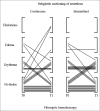Effect of Continuous versus Intermittent Subglottic Suctioning on Tracheal Mucosa by the Mallinckrodt TaperGuard Evac Oral Tracheal Tube in Intensive Care Unit Ventilated Patients: A Prospective Randomized Study
- PMID: 29422724
- PMCID: PMC5793014
- DOI: 10.4103/ijccm.IJCCM_350_17
Effect of Continuous versus Intermittent Subglottic Suctioning on Tracheal Mucosa by the Mallinckrodt TaperGuard Evac Oral Tracheal Tube in Intensive Care Unit Ventilated Patients: A Prospective Randomized Study
Abstract
Background and aims: A risk of tracheal mucosa injury induced by subglottic suctioning has been raised. Therefore, this prospective randomized study aims to compare the effect of continuous suctioning of subglottic secretions versus intermittent suctioning of subglottic secretions (CSSS vs. ISSS) secretions on tracheal mucosa in front of the suctioning port of the endotracheal tube.
Patients and methods: Patients requiring intubation or reintubation in Intensive Care Unit with an expected ventilation duration > 24 h were eligible. Participants received CSSS at -20 mmHg or ISSS at -100 mmHg during 15 s and no suction during 8 s. The effect on tracheal mucosa in front of the suction port was assessed after intubation (T0) and before extubation (T1) using bronchoscopy. Tracheal mucosa damages were graded into five categories (no injury, erythema, edema, ulceration, or necrosis). The occurrence (no injury observed at T0 but present at T1) or the worsening (injury observed at T0 exacerbating at T1) was studied.
Results: Seventy-three patients were included and 53 patients (CSSS, n = 26 and ISSS, n = 27) were evaluable on the primary endpoint. The occurrence or worsening of tracheal mucosal damages did not differ between the two groups (CSSS, n = 7 [27%] vs. ISSS, n = 5 [17%], P = 0.465). Daily average volume of suctioned secretion was higher with ISSS (74 ± 100 ml vs. 20 ± 25 ml, P < 0.001). Impossibility to aspirate was higher with CSSS (0.14 ± 0.16 per day vs. 0.03 ± 0.07 per day, P < 0.001).
Conclusions: Our results suggest that tracheal mucosal damages did not differ between CSSS and ISSS. The aspirated volume was higher and impossibility to aspirate was lower with ISSS.
Clinical trial registration: ClinicalTrials.gov Identifier: NCT01555229.
Keywords: Intensive care; intubation; mechanical ventilation; subglottic secretion drainage; tracheal injury.
Conflict of interest statement
There are no conflicts of interest.
Figures
References
-
- Damas P, Frippiat F, Ancion A, Canivet JL, Lambermont B, Layios N, et al. Prevention of ventilator-associated pneumonia and ventilator-associated conditions: A randomized controlled trial with subglottic secretion suctioning. Crit Care Med. 2015;43:22–30. - PubMed
-
- Muscedere J, Rewa O, McKechnie K, Jiang X, Laporta D, Heyland DK, et al. Subglottic secretion drainage for the prevention of ventilator-associated pneumonia: A systematic review and meta-analysis. Crit Care Med. 2011;39:1985–91. - PubMed
-
- Lacherade JC, De Jonghe B, Guezennec P, Debbat K, Hayon J, Monsel A, et al. Intermittent subglottic secretion drainage and ventilator-associated pneumonia: A multicenter trial. Am J Respir Crit Care Med. 2010;182:910–7. - PubMed
-
- Berra L, De Marchi L, Panigada M, Yu ZX, Baccarelli A, Kolobow T, et al. Evaluation of continuous aspiration of subglottic secretion in an in vivo study. Crit Care Med. 2004;32:2071–8. - PubMed
-
- Girou E, Buu-Hoi A, Stephan F, Novara A, Gutmann L, Safar M, et al. Airway colonisation in long-term mechanically ventilated patients. Effect of semi-recumbent position and continuous subglottic suctioning. Intensive Care Med. 2004;30:225–33. - PubMed
Associated data
LinkOut - more resources
Full Text Sources
Other Literature Sources
Medical


